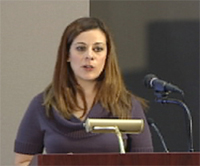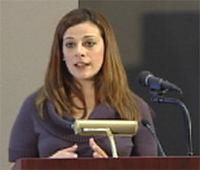March 1, 2011 -- "It’s like an all-you-can eat buffet, but all the options are healthy for you," said Kate Zwaard, the Government Printing Office’s Lead Program Planner for Digital Preservation, in a visit to the Library of Congress on November 16, 2010.
 Zwaard was talking about the GPO Federal Digital System (external link), a suite of tools and services that helps the agency preserve and provide long-term access to the digital publications of the Federal government.
Zwaard was talking about the GPO Federal Digital System (external link), a suite of tools and services that helps the agency preserve and provide long-term access to the digital publications of the Federal government.
A webcast of the event is now available.
"FDsys is a preservation repository in the traditional sense, in that it conforms to the Open Archival Information System reference model (external link) (PDF)," Zwaard said, "but it’s also a content management system and an advanced search engine." And while the FDsys is a modern software environment, the roots of the issues it was designed to solve go back to the early days of GPO.
The FDLP worked remarkably well for print publications for over a century, but as agencies opted to host more and more publications on their websites instead of printing them, it became more difficult for users to find what they were looking for. Instead of going to a library or a catalog and looking for an item, you had to know what organization (or sub-organization) was responsible for producing the documents and where they were posted on the web.
More importantly, no federal government entity looked after preservation of the content for public access. Material could be put on a webpage and taken down the next day, or accidentally corrupted, or rendered unusable by obsolescence of technology.
 Zwaard described the decisions made by the Public Printer of the United States in 2004 to outline a strategic vision to turn what some called "disruptive technologies" into opportunities. GPO had been publishing content to the web for public access through its website GPO Access since 1993, but the Public Printer’s report lead to the development of the more comprehensive FDsys.
Zwaard described the decisions made by the Public Printer of the United States in 2004 to outline a strategic vision to turn what some called "disruptive technologies" into opportunities. GPO had been publishing content to the web for public access through its website GPO Access since 1993, but the Public Printer’s report lead to the development of the more comprehensive FDsys.
"What sets FDsys apart from most preservation repositories is that it is both a content repository and a system that serves as the electronic backbone of the agency," Zwaard noted. "We’ve built a repository that is designed to maintain the usability of our assets free from dependence on specific hardware and software. But a big part of the system is about providing an organization for content and a workflow to help move publications through the agency for cataloging, proofing, print and possible reuse."
Zwaard went on to describe the technological features of FDsys, including the structure of content packages, the content lifecycle and the GPO approach to content integrity and authenticity.
"We have lots of specialized experience in helping people find the government information they are looking for," she concluded, "and our experts thought carefully about the ways users might navigate to what they want and the kinds of metadata we need to collect to support that. In addition, GPO is preparing for a Trustworthy Repositories Audit and Certification audit (external link). I believe we will be the first Federal agency to be audited for TRAC compliance, and we are excited to have someone take a look at our work and suggest places for improvement."
